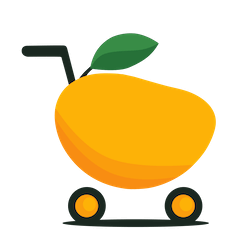If you already know what PLR products are and just want to skip to:
The top 10 ways PLRs are used in top niches today, go here.
The top 20 must-ask questions before buying PLRs, go here.
—
If you don’t really know what PLR products are…
Then after reading this blog post, you’ll understand what they are, how to find quality PLR products, customize them effectively for your specific industry, and implement strategic PLR usage to save time and money while growing your online business.
–
What Exactly Are PLR Products?
PLR stands for Private Label Rights. These are ready-made digital products that you can buy and then use as if you created them yourself. Think of PLR like buying a pre-made cake that you can add your own frosting and decorations to, and serve as your own special dessert.
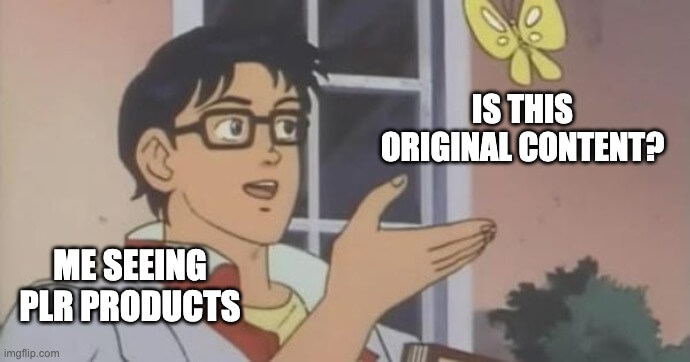
The best part about PLR is that you can put your name on it, change it however you want, and use it in your business. This saves you tons of time compared to creating everything from scratch.
PLR has been around since the early 2000s but has grown hugely popular in recent years. Today, you can find PLR products for almost anything digital – from ebooks to videos, courses, and software.
PLR is different from other content licenses you might see. With Resale Rights, you can only sell the product as-is without changing it. With Master Resale Rights, you can sell the product and your customers can resell it too, but nobody can change it.
When you buy a PLR product, you should always check what the license agreement allows. Each creator might have different rules about what you can and can’t do with their PLR products. Most PLR licenses let you edit the content, add your name as the author, and sell it to your customers.
–
3 Types of PLR Products

1/ Digital Content PLR
The most common PLR products are text-based materials that you can quickly customize. Ebooks and reports are very popular – these are usually PDF files that cover specific topics that you can brand as your own.
Articles and blog posts are another big category of PLR.
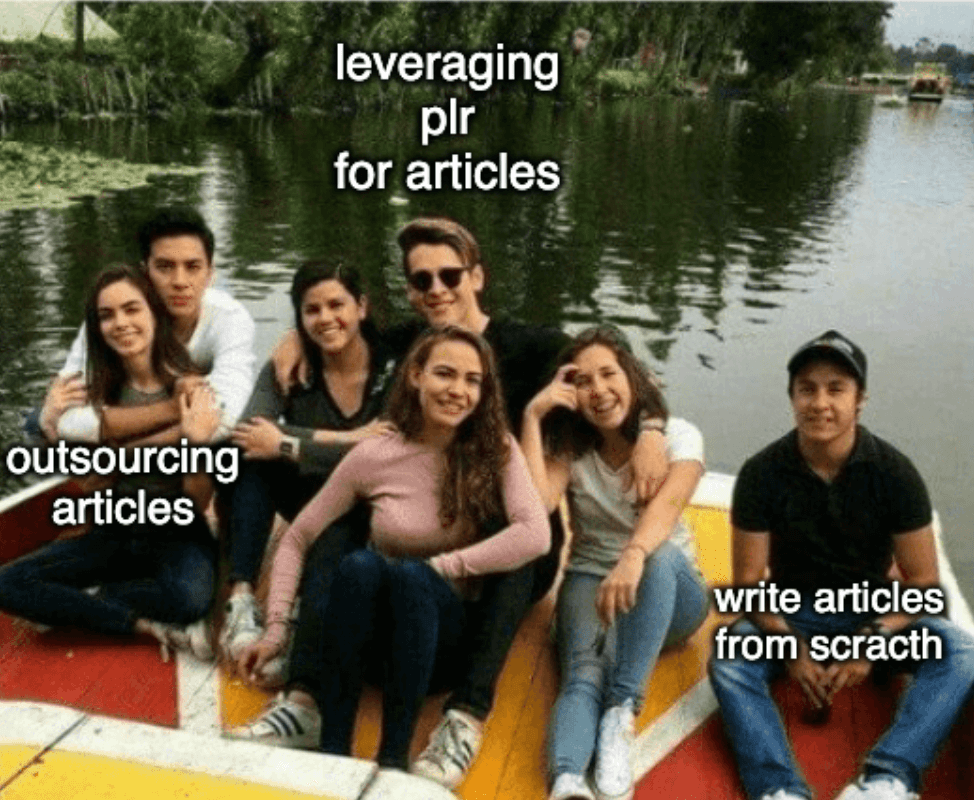
These can save you hours of writing time for your website or social media.
Email sequences are pre-written email messages that you can load into your email system. These can include welcome emails, sales messages, or regular newsletters to keep in touch with your audience.
2/ Multimedia PLR
As more people prefer watching and listening over reading, multimedia PLR has become very popular. Video courses and tutorials can be expensive and time-consuming to create yourself, but with PLR, you can get professional videos ready to use.
Audio content like podcast episodes or guided meditation recordings are also available as PLR. These save you from needing expensive recording equipment or voice training.
Graphics and templates help you create professional-looking social media posts, presentations, and printable materials. These visual assets would normally require design skills, but PLR makes them accessible to everyone.
3/ Software and Tools PLR
The most advanced type of PLR includes software and digital tools you can rebrand. Web applications are complete software products you can sell without knowing how to code.
WordPress themes and plugins let you offer website design and functionality tools with your brand name. Some PLR providers even offer complete software services, though these usually cost more than other PLR types.
–
Key Benefits of Using Private Label Rights Products
The biggest advantage of PLR is saving time.
Creating content from scratch takes hours of research, writing, editing, and formatting. PLR gives you a head start with ready-made content you can quickly customize.
PLR saves you money too. Hiring professionals to create custom content often costs hundreds or thousands of dollars. Most quality PLR products are much more affordable for small businesses.
Another great benefit is flexibility. You can use the same PLR content in many different ways – turn an ebook into blog posts, social media templates or content, and email newsletters. This helps you get more value from each purchase.
–
Common Myths About PLR Products
Many people think all PLR products are low quality, but this isn’t true. While some cheap PLR exists, many providers now offer excellent content created by experts and professional writers. Like anything else, you get what you pay for.
Another myth is that using PLR will hurt your website’s search rankings. Google doesn’t actually “penalize” duplicate content the way many people think. The main issue is which version Google will show in search results, not penalties against your site.
Some worry that using PLR means you’re not being authentic. But PLR is meant to be a starting point that you customize with your own experiences and expertise. When you add your own voice and examples, PLR becomes uniquely yours.
–
How PLR Products Work: What You Can and Can’t Do
With most PLR licenses:
You CAN change the content however you want.
You CAN put your name on it as the author or creator.
You CAN sell it to your customers, use it on your website, or include it in membership programs.
However, there are important limits to understand:
You typically CANNOT sell the PLR rights themselves to others.
You CANNOT claim copyright on unchanged PLR content. Many PLR providers don’t allow you to use their content for spam or misleading claims.
Always read the license that comes with any PLR product you buy. Some creators have special rules about how many copies you can sell or where you can use their content.
–
10 Ways PLRs Are Used in Top Niches Today
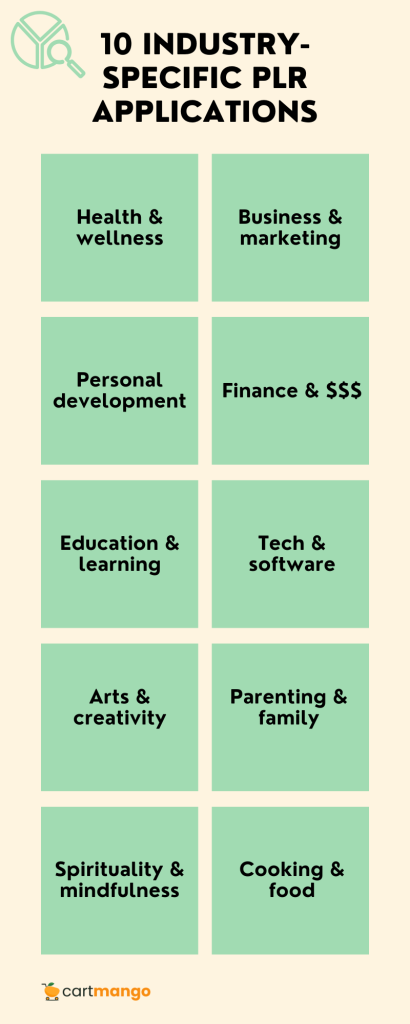
1/ Health and Wellness
Health coaches and wellness experts love using PLR to create resources for their clients. Popular items include workout plans, healthy recipe collections, and meditation scripts.
The key to success is making sure all health information is accurate and up-to-date. Adding your personal health philosophy and success stories makes these resources much more valuable to your specific audience.
2/ Business and Marketing
Business coaches find PLR incredibly useful for creating training materials and client resources. Ready-made business plan templates, marketing checklists, and social media content calendars save hours of creation time.
The best business PLR users add their own real-world examples and case studies to make the content practical and relevant. Your unique business approach and methodology should shine through the customized materials.
3/ Personal Development
Self-help coaches and personal growth experts often use PLR for workbooks, goal-setting guides, and mindset resources. This niche focuses on transformation and achievement.
Successful implementers in this space add their personal stories of overcoming challenges. These authentic additions make the content much more powerful and relatable to clients.
4/ Finance and Money
Financial advisors use PLR to explain complex money concepts in simple terms. Budget worksheets, debt reduction plans, and retirement calculators are popular in this category.
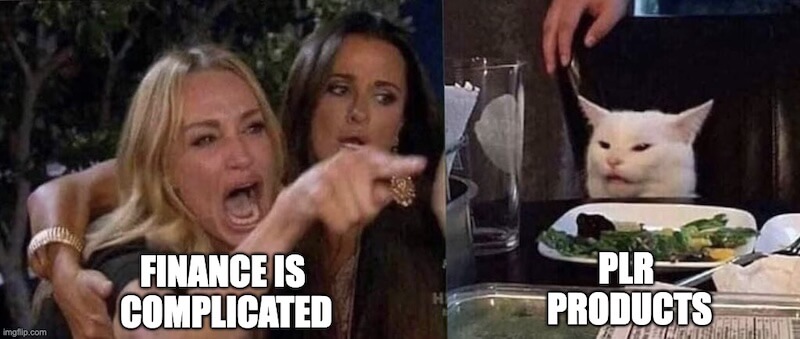
When using finance PLR, always make sure the information fits your location’s laws and regulations. Adding specific examples based on your clients’ typical financial situations makes the content much more helpful.
5/ Education and Learning
Online course creators and teachers use PLR to build comprehensive learning materials. Language learning resources, technical tutorials, and skill-building courses save enormous development time.
The best education PLR users enhance materials with their teaching style and additional practice exercises. Adding interactive elements and assessments significantly improves learning outcomes.
6/ Technology and Software
Tech trainers and digital product creators leverage PLR for tutorials and user guides. This niche includes software training, coding examples, and technology comparison charts.
Making tech content accessible requires adding simple explanations and real-world applications. Breaking down complex tech concepts helps your audience implement what they learn.
7/ Arts and Creativity
Creative entrepreneurs use PLR to develop instructional content and project ideas. Art tutorials, craft patterns, and creative planning guides help makers develop new skills.
Successful implementers add their unique artistic style and examples of finished projects. These additions inspire your audience while showcasing your creative expertise.
8/ Parenting and Family
Family coaches use PLR to create resources for navigating parenting challenges. Activity guides, behavior charts, and developmental milestone trackers save parents valuable time.
The most effective customization includes adding age-specific recommendations and cultural considerations. Your personal parenting philosophy should be woven throughout the materials.
9/ Spirituality and Mindfulness
Spiritual teachers use PLR for meditation scripts, reflection journals, and personal growth exercises. These resources help people develop deeper awareness and connection.
Recording audio versions of written meditations adds great value. Adding context from specific spiritual traditions helps create a more meaningful experience for your audience, especially for plr journals.
10/ Cooking and Food
Food bloggers and nutrition coaches use recipe PLR to expand their content offerings. Meal planning templates, specialized diet guides, and recipe collections save hours of kitchen testing.
The most successful food PLR users add their own photos of the prepared dishes. Adding nutritional information and personal cooking tips makes the content much more valuable.
–
Customize Your PLR Using These 5 Methods
1/ Complete Restructuring
Go beyond basic editing by completely reorganizing the generic PLR content. Move sections around to create a better flow for your specific audience.
You can use AI tools to help rewrite sections while keeping the main information. Create transitions between sections that weren’t in the original PLR to make the content flow naturally.
Replace generic examples with specific scenarios that relate to your industry. This makes the content much more relevant and useful to your audience.
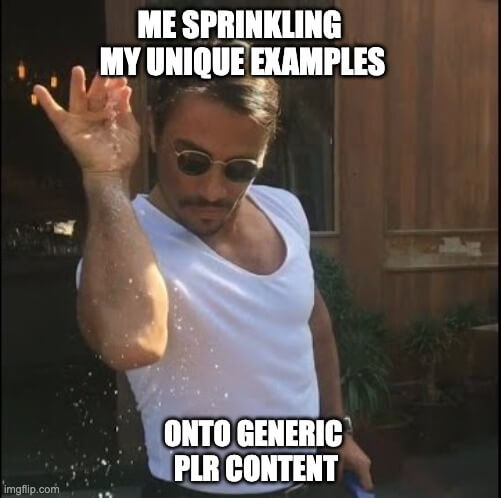
2/ Adding Multimedia Elements
Transform text-based PLR into engaging experiences by adding different content formats. Turn written lists into colorful infographics that make information easier to understand at a glance.
Record video demonstrations that expand on concepts mentioned in the written PLR. Create audio versions with background music to accommodate different learning styles.
Add interactive elements like quizzes or calculators that transform passive content into an engaging experience. These additions significantly increase the value of the original PLR.
3/ Making It Work for Different Audiences
Adapt PLR content to work for specific groups or locations that you serve. Change examples and references to match your target audience’s experiences and challenges.
Replace generic currency or measurement references with ones specific to your region. Adjust recommendations to account for local laws, cultural norms, and market conditions in different areas.
4/ Using Data and AI for Personalization
Use customer information and AI tools to create personalized versions of your PLR content. Set up your content to show different examples based on the reader’s industry or experience level.
Create content blocks that can be toggled on or off depending on the specific customer’s needs. Develop recommendation systems that suggest relevant sections based on user behavior.
5/ Complete Design Makeover
Transform the look and feel of PLR content with professional design elements. Create a style guide for your PLR content that ensures everything matches your brand colors and fonts.
Design custom covers, layouts, and graphics that completely change how the original PLR looks. Use custom typography, icons, and illustrations to replace any generic visuals in the original package.
–
Top 20 Must-Ask Questions Before Buying PLRs
When buying PLR products, you need to know how to spot the good stuff from the poop stuff.
Here’s what to look for:
| What to Check | What Good Looks Like | Rating Scale |
|---|---|---|
| === CONTENT QUALITY === | ||
| Is the information accurate and up-to-date? | Contains current facts and research | 1=Outdated, 5=Current |
| How’s the writing style? | Clear, engaging, and professional | 1=Poor, 5=Professional |
| Is it well-organized? | Logical structure with clear sections | 1=Chaotic, 5=Logical |
| Are facts backed up? | Includes sources for claims made | 1=Unsourced, 5=Well-documented |
| === VISUAL APPEAL === | ||
| How does it look overall? | Professional design that looks polished | 1=Amateur, 5=Professional |
| What about the images? | High-quality graphics and photos | 1=Low-resolution, 5=High-quality |
| Is formatting consistent? | Consistent headings, fonts, and spacing | 1=Inconsistent, 5=Polished |
| For videos/audio, how’s the quality? | Professional recording with good sound | 1=Poor, 5=Professional |
| === TECHNICAL STUFF === | ||
| Will the files work with your tools? | Standard formats that open easily | 1=Outdated formats, 5=Standard formats |
| For software, does it work well? | Clean code without bugs or errors | 1=Buggy, 5=Clean |
| Does it work on mobile devices? | Adjusts properly for phones and tablets | 1=Desktop-only, 5=Fully responsive |
| How fast does it load? | Optimized files that load quickly | 1=Slow, 5=Optimized |
| === RIGHTS & RULES === | ||
| Is the seller legitimate? | Clear ownership and selling rights | 1=Questionable, 5=Verified |
| What can you do with it? | Flexible usage rights for your needs | 1=Highly restricted, 5=Flexible |
| Are there unusual limitations? | Standard terms without strange rules | 1=Many restrictions, 5=Standard terms |
| Can you use it commercially? | Clear permission for business use | 1=Ambiguous, 5=Clear rights |
| === SUPPORT & UPDATES === | ||
| How often is it updated? | Regular updates to keep content fresh | 1=Never updated, 5=Regular updates |
| Is help available if needed? | Support available for questions | 1=No support, 5=Comprehensive support |
| How quickly do they respond? | Prompt answers to questions | 1=Unresponsive, 5=Quick and helpful |
| Do they provide extra resources? | Additional tools or bonuses included | 1=None available, 5=Extensive resources |
–
The Ethical Side of Using PLR
Finding the right balance between convenience and authenticity is key when using PLR.
While PLR saves time, it shouldn’t replace your unique expertise and voice completely.
A good rule of thumb is to change at least 50% of any PLR content you use. Add your personal experiences, client examples, and specific methods to make the content truly valuable and authentic.
Some business owners openly tell their audience they use PLR, while others don’t mention it. PLR licenses don’t usually require you to disclose that you used PLR content. However, being honest about your content sources can build trust with your audience.
Consider saying something like: “This guide uses industry-standard frameworks that we’ve enhanced with our unique approach and client experiences.” This acknowledges outside influences without specifically mentioning PLR.
–
Using PLR to Test Business Ideas
One of the smartest ways to use PLR is to test new business ideas without spending months creating content.
Instead of developing a complete course or product that might not sell, use PLR to quickly launch a simple version and see if people are interested.
This approach works especially well when exploring new topics where you’re not sure if your audience will respond. By watching how people interact with and purchase your PLR-based products, you can make better decisions about where to invest your time.
Start by finding high-quality PLR that closely matches what you want to offer. Make the most important customizations to reflect your unique value, but don’t spend weeks perfecting every detail yet.
Include ways to get feedback, like surveys or comment sections. Based on how people respond, you can decide whether to create a fully custom version, continue improving the PLR version, or try a different product idea altogether.
–
PLR Product Stack Strategy
Instead of using single PLR products, smart entrepreneurs create complete systems using multiple PLR items. Start by mapping out your customer’s journey from first finding you to becoming a loyal client.
Buy PLR products that address different parts of this journey, making sure they use similar terms and approaches. Connect these separate pieces by creating consistent branding and adding transitions that guide users from one resource to the next.
Consider creating different levels of products at various price points.
E.g. Use a free PLR-based checklist to attract new leads, a low-cost PLR ebook as their first purchase, and a more comprehensive PLR course as your premium offering.
You can also create specialized tracks for different types of customers. For instance, have one set of PLR-based resources for beginners and another for advanced users, or different packages for various industries you serve.
–
Finding Quality PLR Products
The market for PLR has grown significantly, with many places to find content in almost any topic.
When shopping for PLR, look for providers that offer detailed product descriptions and clear license terms. The best PLR sellers let you see samples before buying so you can check the quality.
Watch out for warning signs like extremely low prices (quality content costs money to create), unclear licensing terms, or sellers making wild claims about “push-button” results. If it sounds too good to be true, it probably is.
Prices vary widely depending on what you’re
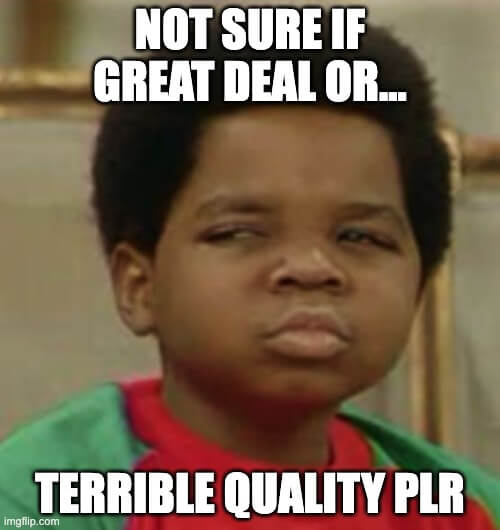
buying. Simple article packs might cost $10-20, while complete video courses could range from $100-500. Think about how you’ll use the content and what return you expect before deciding what to spend.
Regarding where to buy/source the PLR products, here’s a list of where to buy digital products to resell.
–
PLR Products vs. Creating Original Content
The time difference between purchasing PLR content and creating content from scratch is huge.
Writing a 10,000-word ebook yourself might take 40-60 hours, while customizing a PLR ebook of similar length might take just 5-10 hours. This efficiency lets you produce more content in less time.
Cost comparisons also favor PLR for most businesses. Hiring a writer might cost $0.10-0.50 per word, making a 10,000-word project cost $1,000-5,000. Quality PLR ebooks on the same topic might cost $50-200, saving you significant money even after you spend time customizing it.
The decision to use PLR or create original content depends on several factors.
PLR works best for standard information and supporting materials. Original content makes more sense for your core methods, signature processes, and highly specialized topics where you have unique expertise.
–
Common Challenges with PLR Products and Solutions
Market saturation happens in popular PLR niches where many businesses use similar base content.
Combat this by thoroughly customizing your PLR, adding unique research or data, and combining multiple PLR sources to create something truly original.
Quality varies widely between PLR providers, with significant differences in writing, design, and accuracy. Deal with this by carefully checking samples before buying, reviewing the entire product after purchase, and being prepared to enhance lower-quality sections with your own expertise.
Standing out when others have access to the same PLR can be challenging. Overcome this by developing a strong brand voice throughout the content, adding multimedia elements others might not include, and creating unique frameworks that provide structure to the PLR content.
Legal considerations include ensuring proper usage rights and avoiding copyright issues. Always buy PLR from legitimate sources, carefully review license terms, and keep records of your purchases and the associated rights.
–
Is PLR Right for You?
PLR products can help businesses create content more efficiently, saving time and money while better serving your audience. But remember that successful PLR use demands proper customization and strategic implementation – simply using it without changes rarely works.
Start small with a PLR purchase in an area where you need content but lack time to create it yourself.
Experiment with different customization approaches and pay attention to audience feedback.
When used correctly, PLR becomes a valuable tool that lets you focus your original creation efforts where they’ll make the biggest impact.
The key is viewing PLR as a starting point for your unique content, not a finished product.
Related
- Gumroad vs Sellfy: The Vendor Lock-in Cage (2025)
- Gumroad vs Payhip: The Hidden Trap for Creators (2025)
- ThriveCart vs SamCart – The Subscription Hostage Trap (2025)
- 8 ThriveCart Alternatives & The Lifetime Pricing Paradox (2025)
- 8 SamCart alternatives + Subscription hostage (2025)
- The GENTLE Method: Soft marketing for creators
- How Far in Advance Should You Promote a Webinar?
- The SAVINGS Method: The Productivity Improvement Plan for Creators
- 9 Questions to Ask: How to Hire a Digital Marketing Agency
- Decision That Costs Millions? Marketing Funnel vs Customer Journey
